Submitted by WA Contents
Estonian National Museum’s ’’Echo of the Urals’’ named the best permanent exhibition of the year
Estonia Architecture News - Feb 07, 2017 - 17:04 20020 views

Estonian National Museum’s ''Echo of the Urals'' named the best permanent exhibition of the year. The newly-opened Estonian National Museum in Tartu, Estonia offers both fascinating new world-class architecture and a very contemporary take on museum exhibitions.

One of the two large permanent exhibitions - Echo of the Urals - focussing on introducing all the Northern Finno-Ugric cultures, was awarded the best new permanent exhibition prize on January 27 at the Annual Museum Awards Gala of Estonian museums. The exhibition is based on the concept of anthropologist Art Leete and was put together by curators from the Estonian National Museum.
Echo of the Urals was designed and produced by interior architects JANKEN Wisespace and design agency Velvet.

According to one of the designers of the exhibition, Velvet’s design lead Kristian Kirsfeldt, the team found their inspiration from ethnofuturism, a delicate cultural strategy by which you preserve patterns of archaic cultural diversity by interweaving ancient tradition into contemporary cultural field. "For us, it meant "inhaling" preserved patterns from textiles, daily tools, petroglyphs, and "exhaling" a contemporary take.

The goal of the graphic design as well as architectural design in the exhibition was to create a new, clearly perceptible layer of exposition surrounding the ethnographic exhibits: one relating to, but not mixing with the originals.

As a result, Echo of the Urals became an environment which is a unique combination of experience, emotion and facts. There is something for all the senses.
But before anything else, this exhibition is meant to be perceived with the heart. The Finno-Ugric nations are our family members, kinsmen, friends – being allowed to be part of their lives, stories and dreams is an invaluable thing to experience," Kirsfeldt explained.

The exhibition is split into four exhibition halls, each of them dedicated to a few of the language groups, but also to a certain time of day and a season. Moving through the space, the visitor is taken from a spring morning to a summer day, followed by an autumnal afternoon and wintery night.
Jan Graps, the interior architect of the exhibition, says that the exhibition design - created during an extraordinary long period of around 8 years - has by now started to live its own life.

"It has formed a complete spatial environment, the visitor can take the time of and completely forget the outside world for a while. E.g. sit behind the Komi hut table and get the feel of distant peoples way of life, feel their hospitality and delve into the variety of their national cuisine, while listening to the calming snuffle of the virtual grandfather sleeping behind the furnace,'' says Jan Graps.
''Or sit on the bench in front of the Karelian sauna, looking at the rocky coast in sunset, listening to the calls of herons and just let your mind wander. Perceive the progression of time in these worlds and the similarities to our own lives,'' Graps suggests.

The exhibition also boasts an interactive sound installation that is likely the largest in the world. Created by soundscape designer Taavi Tulev, the installations spreads over 1000 square metres and uses 126 speakers to emit sound from 140 channels.

The spatial experience that this creates, takes the visitor on a trip to the locations where the tiny Finno-Ugric nations live. Each of the spaces sets the mood by using seasonal sounds of migrating birds, the splashing of a stream, crackling fire, winter gales, etc.








Exhibition level plan

Exhibition 2nd level plan
All images © Kaido Haagen
> via JANKEN Wisespace
